Posted by Anita on 10.16.07 12:02 PM
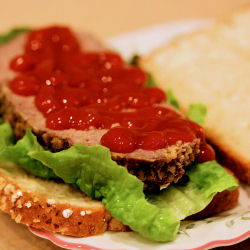 You learn the darndest things when you blog.
You learn the darndest things when you blog.
Here’s just one example: Until a few days ago, I never knew that one of my all-time favorite foods was so widely appreciated. I mean, I knew meatloaf sandwiches were something other people ate, but I had no idea they loved them as much as I do.
That is, until the day I posted this photo on Flickr and the comments started rolling in:
“One of the best uses of leftovers of all time.”
“Nothing better [than a meatloaf sandwich].”
I’m right there with them. I may love meatloaf sandwiches even more than I like the original meatloaf dinner. Which is impressive, considering my adoration for baked potatoes knows no bounds.
For those of us in the meatloaf-sandwich-lovers clique, there’s no need to wait for a special occasion to celebrate. But in case you’re seeking an excuse, Serious Eats declared this Thursday National Meatloaf Appreciation Day, and we’re all invited to play along.
Don’t tell me that you don’t have a prized family recipe to bring to the party? Oh, you poor thing. Here… pull yourself together. Sit down and let me give you a copy of ours.
But first, a few caveats:
Our family meatloaf is a bit of an anomaly. It doesn’t come topped with pan gravy, or even a tomatoey glaze. (Although Heinz ketchup is a mandatory condiment, as far as I’m concerned, it’s absent from the cooked dish.) This recipe also eschews breadcrumbs as a binder; Quaker Oats serves that purpose. An unorthodox choice, to be sure, but the end result is less bizarre than you might expect.
In place of the usual middle-American seasonings, our meatloaf features some strange-sounding spices. Happily for any purists among us, they fly under the radar, adding their warmth without making anyone think of an oatmeal cookie. Perhaps the biggest heresy of all: This meatloaf isn’t baked, or even shaped, in a loaf pan. Sporting the freeform curves of a football (make that ‘rugby ball’ outside the US), our odd-shaped loaf maximizes the crusty edges our family covets.
And because the resulting slices are just a teeny bit wider than the average piece of bread, the elliptical shape yields some delicious trimmings — perfect nibbles during the next day’s sandwich-making activities. Lucky you.
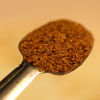
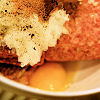



Mom’s Meatloaf
1-1/2 pounds ground chuck
1/2 pound pork breakfast sausage
1 onion, grated
1 egg
1 cup uncooked oatmeal (not instant)
1/4 cup milk
1 tsp salt
1/4 tsp ground black pepper
1/2 tsp nutmeg
1/2 tsp allspice
Preheat oven to 350°F. Combine all ingredients in a large bowl until well mixed. Pat into a football shape and place in a wide baking dish or a small roasting pan. Bake for 75 minutes, or until juices run clear when the center is pierced with a knife.
family, meat, other blogs, recipes
12 Comments »




Posted by Cameron on 10.15.07 7:02 AM
 A big shout out to Natalie over at The Liquid Muse for choosing food/cocktail pairings as the Mixology Monday topic for October. My proposal for a decadent lunch (or bachelor’s dinner) is a steak and bleu cheese sandwich paired with an ice-cold Martini — one of my all-time favorite combinations.
A big shout out to Natalie over at The Liquid Muse for choosing food/cocktail pairings as the Mixology Monday topic for October. My proposal for a decadent lunch (or bachelor’s dinner) is a steak and bleu cheese sandwich paired with an ice-cold Martini — one of my all-time favorite combinations.
This is no tame, civilized snack. The sandwich should be rough and ready. You’ll need slices of cold beef left over from the loud debauchery at the grill Saturday night; a good, chewy roll; a wedge of bleu; plus a spreading knife and the guts to use it.
No lettuce. No mayonnaise. No mustard.
This particular Martini you want to be rippingly cold and (to borrow a winning concept from The Art of the Bar) made with Atomic Age proportions of gin and vermouth. Skip the orange bitters; you’ve already got a lot of flavors coming together.
Consume while watching a sporting match, taking in an action flick, or plotting your next corporate takeover.




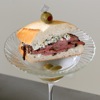
Steak and Bleu Sandwich
Cold sliced steak
Bleu cheese at room temperature
Chewy sandwich roll
Slice open roll. Spread several healthy swipes of bleu cheese on both halves. Layer bottom half with steak slices, and top with the other half. Eat.
 Atomic-Age Martini
Atomic-Age Martini
2 oz gin
1/2 oz (or less) dry vermouth
Combine ingredients in an ice-filled mixing glass. Stir until icy cold. Strain into a chilled cocktail glass, and garnish with an olive or two.
drinks, meat, Mixology Monday, other blogs, recipes
6 Comments »




Posted by Anita on 10.12.07 10:57 AM
 Las Vegas is perhaps the last place on the planet you’d expect to find anyone attempting to practice the locavore lifestyle. It’s the kind of city, after all, where restaurants brazenly tout their ‘locally caught salmon’ knowing full well that the closest ocean lies more than 300 miles away. (Perhaps they’re secretly stocking Lake Mead with King and Chinook?)
Las Vegas is perhaps the last place on the planet you’d expect to find anyone attempting to practice the locavore lifestyle. It’s the kind of city, after all, where restaurants brazenly tout their ‘locally caught salmon’ knowing full well that the closest ocean lies more than 300 miles away. (Perhaps they’re secretly stocking Lake Mead with King and Chinook?)
But the evidence that times are a-changing is there in black and white: Wednesday’s Review-Journal Living section featured a front-page story on chefs seeking out local purveyors and farmers attempting to create a market for their produce. To my surprise, a fair number of crops are grown within an hour’s drive of Sin City, just over the hill in Pahrump — a town better known for its ‘chicken ranches‘ than its vegetable farms.
And there’s more good news, quite literally just over the horizon. Although the Las Vegas Valley’s extreme temperatures — well over 100 in the summer and occasionally below freezing in winter — make large-scale farming nearly impossible, the nearby valleys of Southern Nevada can support a wide variety of carefully selected crops. Although water-intensive fields of alfalfa and grain are out of the question, the article points out that water-conscious drip irrigation (much like the kind we use in our own mini-orchard) is particularly well-suited to food crops grown for humans, rather than livestock. The UNLV cooperative extension specialists are working with folks interested in raising “everything from natural beef and pheasants to vegetables and fruit”, right within shouting distance of the neon and nightlife.
It’s a fascinating article about a region in transition. One only hopes they gain some traction before the local housing boom puts pressure on farmers to sell out to developers of yet another slapped-together townhouse pod.
The story arrived too late for me to explore many of its finds — the lone retail farmer mentioned operates a stand only from June through September. But I’m ecstatic to read that Whole Foods has her farm, and presumably others like it, under contract for next year’s harvest. The last time I was in town, just months ago, the local Whole Foods in Henderson was trucking in every last apple and avocado they sold all the way from our very own Central Valley. Most of their produce had travelled almost as far as I had, and some even hailed from another hemisphere. I suspect we have Michael Pollan to thank for this radical change, for holding Mr. Mackey’s feet to the fire.
—–
You can even find backyard edibles from green-thumbed gardeners making the most of their fickle surroundings. Some Asian friends have a few makrut lime trees, and another grows cilantro so prolifically that she can share giant batches with her friends. The neighbor up the hill has wide-paddle cactus along his fence; I doubt he’s making nopales, but we do see him harvesting tunas with a pliers now and then. (Let’s hope he’s making Margaritas with the juice.)
But although you might expect to find edible cacti among the sand and sagebrush, the desert is full of other surprises. On my last full day in town, Mom’s friend from across the street arrived bearing a pair of picture-perfect pomegranates from her own backyard. It’s one of those smack-your-forehead discoveries: These seedy fruits hail from the Middle East, so they’re well-adapted to dry desert climes. The ones grown just feet from our front door were large and beautiful; they weren’t as sweet as the cultivated variety, but they would make a delightful addition to a winter salad or a garnish for chiles en nogada.
Next time, we’ll have to put aside the casseroles and meatloaf for one night, and see where the desert leads us. Perhaps by then, even Whole Foods will have made good on its agenda, and ‘local Southern Nevada produce’ might no longer be an oxymoron.
locavore, Vegas
5 Comments »




Posted by Anita on 10.12.07 7:09 AM
 I distinctly recall the first time I drank a Whiskey Sour. Our friends Jason and Maggie, eking their way through grad school, lived in East Palo Alto (pre Four Seasons, pre Ikea). Their apartment sat tucked behind a bungalow facing the 101 frontage road. The neighbor who lived in said bungalow was an affable fellow named Drew, a long-haired techie, musician, and tinkerer. The bungalow inevitably became the scene of numerous jam sessions: late-night sing-alongs fueled by a potent mixture of whiskey, powdered sugar, ice, and the juice of the Meyer lemons that grew right outside Drew’s kitchen window… all whizzed up in the blender. (Hey, we were young.)
I distinctly recall the first time I drank a Whiskey Sour. Our friends Jason and Maggie, eking their way through grad school, lived in East Palo Alto (pre Four Seasons, pre Ikea). Their apartment sat tucked behind a bungalow facing the 101 frontage road. The neighbor who lived in said bungalow was an affable fellow named Drew, a long-haired techie, musician, and tinkerer. The bungalow inevitably became the scene of numerous jam sessions: late-night sing-alongs fueled by a potent mixture of whiskey, powdered sugar, ice, and the juice of the Meyer lemons that grew right outside Drew’s kitchen window… all whizzed up in the blender. (Hey, we were young.)
Like the Cape Codder and the Gin & Tonic, the Whiskey Sour is one of those highly adaptable libations that can be successfully concocted nearly anywhere. The lemon juice puts it a bit beyond the reach of the average hotel minibar, but anyone with access to an airport lounge, a rural grocer, or a even a half-decent convenience store can enjoy a respectable version without much fuss.
Depending on your personal palate and your choice of whiskey — in deference both to old memories and my mom’s limited provisions, we brought out the Beam — do vary the amount of simple syrup. Canadian, bourbon, blended, even rye… they’re all fair game here. Our bottom-shelf version, complete with a WalMart nuclear cherry on top, was perfectly fine; I can hardly wait to mix one up with the good stuff when I get home.


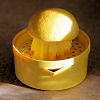

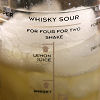
Whiskey Sour
1-1/2 oz fresh lemon juice
2 to 2-1/2 oz whiskey
1/2 to 1-1/2 oz simple syrup
lemon wedge and cherry for garnish
Shake the juice, whiskey, and syrup with ice; strain into a chilled sour glass or rocks glass. Garnish with the lemon wedge and cherry.
Drink of the Week, drinks, recipes
7 Comments »




Posted by Anita on 10.11.07 5:12 PM
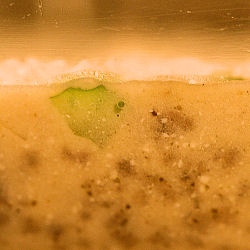 The lovely and talented Jennifer of Last Night’s Dinner challenged me to divulge the five foods that I’m ashamed to love. After chewing on this meme for nearly two weeks, I have a confession to make: There aren’t a lot of foods I’m embarrassed about anymore.
The lovely and talented Jennifer of Last Night’s Dinner challenged me to divulge the five foods that I’m ashamed to love. After chewing on this meme for nearly two weeks, I have a confession to make: There aren’t a lot of foods I’m embarrassed about anymore.
Some of my former foibles have fallen by the wayside. After reading up on the delightful ingredients in my once-beloved Fresca — what the hell are ‘brominated vegetable oil’ and ‘ester of wood rosin’ doing in my soda pop? — I’ve managed to get that particular grapefruit-flavored monkey off my back.
There are plenty of foods that I like that other people find amusing. I take a fair bit of good-natured ribbing about the frequency of my macaroni salad consumption, but it’s hardly the stuff of blushes and stammers. Sure, there’s a slight bashfulness about my regular indulgences in cheesy Mexican combo plates …but I eat enough of the real stuff that I can accept my fondness for the less-authentic version as a regional quirk. I’ve made peace with my unholy love of canned corned-beef hash, and even found a few foodie friends who share my tragic attraction to the pink cylinder of doom. But even this, the worst hyper-processed dreck of the lot, I wear as as a badge of my eclectic taste rather than anything I’m actually trying to hide.
But there is one food I’m just a wee bit embarrassed to love: Casseroles.
When we were kids, Mom always managed to make fabulous dinners on a slim budget. Our evening meals were never gourmet (that was Grandpa’s turf), but they always tasted great. Shake-n-Bake chicken with rice, meatloaf and baked potatoes, even the occasional steak on the grill… we must’ve been the only kids on the block who didn’t have to be coaxed to clean our plates. One-dish suppers were the mainstays of our family diet: Mexican lasagna, a pair of tuna casseroles — one with curried rice, another simply called “That Tuna” — and the frankly named Oven Put-Together. But the queen of them all, the one I still crave, was a homely little dish called Creole Rice.
Much like so many of the faux-ethnic dishes of 70s, there’s not much ‘Creole’ about this mélange. (I suppose it’s slightly more authentic than the disgusting-sounding ‘Thai’ Pepper Salad that my friend Michael recently dredged up. Secret ingredients: Bulls-Eye BBQ Sauce and Miracle Whip…). And while we’re being honest, Creole Rice is definitely one dish that won’t win a single beauty contest — it’s about as beige as can be.
But it’s comfort food in the extreme, at least for my family, and Cameron eats it without too much smirking. I jokingly call it Trailer Park Paella (though it’s closer to Redneck Risotto), but that doesn’t stop me from hauling out the old recipe card a few times a year. Still, that red-and-white can of Campbell’s cream of chicken soup lurking in the dark recesses of our pantry was cause for more than a little locavore angst.
Inspired by The Homesick Texan’s recent post about revamping her hometown favorite, King Ranch Chicken, I decided to see if we might be able to remove the store-bought gloop from good ol’ Creole Rice without losing its homespun charm. Given that the soup was really the only scary ingredient, it wasn’t terribly hard; if you use homemade breakfast sausage, you can probably even make it entirely with local ingredients.


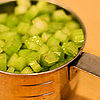
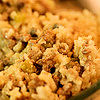
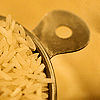
Creole Rice Redux
2T salted butter
2T flour
3 cups chicken stock
1/4 tsp black pepper
1 cup sour cream
1 pound pork breakfast sausage
8 to 12 oz white mushrooms, sliced
1 cup diced celery
1 cup diced onion
1 cup uncooked long-grain rice
Preheat the oven to 350 degrees F.
Melt the butter over medium heat in the bottom of a large saucepan, then add the flour. Whisk continuously until the flour browns slightly — you’re looking for a blonde roux. Add the chicken stock and bring to a boil; reduce heat and simmer for a few minutes until it reaches a thin but sauce-like consistency. Add the pepper and taste for seasoning, adding salt and more pepper if needed. Remove from heat and stir occasionally until warm but not hot. When cooled a bit, add the sour cream and stir until well combined.
While the sauce cools, sauté the pork sausage until browned, crumbling into small chunks. Remove the sausage from the pan with a slotted spoon, and place in the bottom of a large casserole. In the sausage fat (or oil, if you prefer) sauté the mushrooms until cooked but not dry. Add to the casserole on top of the meat, then top with the chicken sauce-sour cream mixture. Layer the remaining ingredients in the casserole in the order listed — do not stir. Push down any rice that rises above the level of the liquid, then cover and place in the oven for 75 minutes.
At the 60 minute mark, remove the casserole lid. The dish will still be fairly soupy at this point; push down any rice that has risen above the liquid, and continue to cook until the rice has absorbed all of the liquid, 15 to 25 minutes more.
Serve hot, with the curtains drawn.
family, other blogs, recipes
11 Comments »




Posted by Anita on 10.05.07 7:04 AM
 As I walked down the escalator to baggage claim at the Las Vegas airport, Mom glanced at the jacket slung over my arm, a wide smile breaking across her face.
As I walked down the escalator to baggage claim at the Las Vegas airport, Mom glanced at the jacket slung over my arm, a wide smile breaking across her face.
“Did you need that coat at home?” she quipped. “You sure won’t need it here!”
When temperatures hover in the 90s in the late afternoon, even in October, you begin to wonder if Las Vegas might not be enchanted by some sort of spell: a warped incantation that keeps the Southern Nevada desert sparkling-hot at the same time as the rest of the country is starting to think seriously about airing out their woolen sweaters and setting a savory stew on the fire.
The notion of a mischievous spirit was never far from my mind as I dug deeper into my cocktail books and online sources for another suitable Strega cocktail. As I sweltered away, I sampled tall drinks, fizzy drinks, and citrus-spiked drinks designed to beat the heat. But they all felt a little blah, like unimaginative variations on better-known concoctions. I kept wishing that I could add an ingredient or two, play with proportions, and generally jack up the flavors. But tempting though that notion was, it’s entirely contrary to the purpose of “Raiders of the Lost Cocktail” — to rescue an existing recipe from cocktail oblivion.
Digging through the eGullet archives for cocktail-book suggestions for further research, I stumbled upon an old Strega thread. In the midst of a general discussion of Strega’s merits and quirks, I noticed a mention of an unnamed Strega cocktail served at Seattle’s Troiani restaurant. Enchanted by the description of a drink that “starts fresh and strong and ends like a wisp of dessert”, I knew I had to add this to my trials.
Unfortunately, the post dated from the restaurant’s early days… many moons and several staff-changes ago. Ever hopeful, I called Troiani one afternoon and asked if anyone in the bar might remember the drink’s proportions. Unsurprisingly, the answer was no. (Well, more like “Huh? What’s Stray Gull?”) Nobody could even tell me who might have tended bar there, all those eons ago — two and a half years is an eternity in the restaurant world.
All I had to go on was a list of ingredients in the post: Vodka, Strega, crème de cacao, orange and lemon juice, with a vanilla cream float. Nothing like that existed in any of the books at my disposal, nor in CocktailDB or any other familiar online source; it must have been someone’s in-house creation. Over on a site called DrinksMixer — where their ‘Most Popular’ sidebar inauspiciously lists the Apple Martini, Jager Bomb, and Long-Island Ice Tea among the top five — I noticed a similar drink, with a most appropriate name.
If it were mine to tinker with, I’d suggest you make the Sun Witch with a lighter hand on the creme de cacao. If you do as Troiani’s sadly anonymous bartender did, adding lemon juice and vodka, you’ll enjoy a lighter finish… at least as far as these sorts of milkshake drinks go. If you’re in the mood for a dessert cocktail, you could do far worse than to fall under the Sun Witch spell.





Strega Sun Witch
1 oz Strega liqueur
3/4 oz white creme de cacao
3/4 oz orange juice
1 oz whipping cream
Orange slice, for garnish
Shake with ice, and strain into a cocktail glass. Garnish with a slice of orange.
Sun Witch a la Troiani
1 oz Strega liqueur
1/2 oz vodka
1/4 oz white creme de cacao
1/2 oz orange juice
1/2 oz lemon juice
1 oz whipping cream
vanilla extract or vanilla liqueur, to taste
Lightly whip the cream with the vanilla; set aside. Shake the remaining ingredients with ice, and strain into a cocktail glass. Top with the vanilla cream, and garnish with a light grating of orange zest.
Drink of the Week, drinks, other blogs, recipes
3 Comments »




Posted by Anita on 10.04.07 7:42 PM
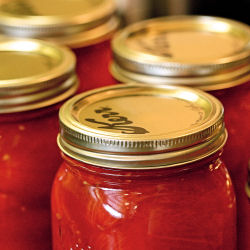 As summer fades into fall, I’m taking great comfort in our pantry full of canned tomatoes. Sometimes I just stand there with the doors open, gazing in at the luxury of summer’s bounty — more than 40 quarts in all — hedged against the privations of winter’s mealy produce. Bought from a local organic farmer at a seriously good price, these tomatoes were picked at their peak of ripeness and processed within 48 hours. Row upon row of jars sit in the cool larder, bright red orbs shining out of the darkness.
As summer fades into fall, I’m taking great comfort in our pantry full of canned tomatoes. Sometimes I just stand there with the doors open, gazing in at the luxury of summer’s bounty — more than 40 quarts in all — hedged against the privations of winter’s mealy produce. Bought from a local organic farmer at a seriously good price, these tomatoes were picked at their peak of ripeness and processed within 48 hours. Row upon row of jars sit in the cool larder, bright red orbs shining out of the darkness.
Gag-inducing, isn’t it? But I must confess that the road all this unseemly self-congratulation was paved with dismal failure.
A few weekends ago, Cameron and I blanched and peeled 40 pounds of Mariquita Farms San Marzano tomatoes. Later in the day, Tea popped over to help us fill cases of quart-sized canning jars with our haul. Seven quarts at a time, we arranged our bounty into the shiny-new pressure canner, sealed the lid, and waited.
We’ve put up jams and preserves for many years, and pickles for at least the last five. But our first foray into the tomato realm was a rather limited success. Almost a third of the jars didn’t develop a proper seal. Of those that did, half lost so much liquid that we feared they would spoil. (Reputable books tell us not to worry: the contents may darken, but they’re safe to eat.) We toyed with the idea of re-processing the unsealed jars, but with no clue as to what had gone wrong and exhausted from a day on our feet, we decided that we’d had enough.
But the next morning, in what can only be described as a “when life gives you lemons” moment, I realized that we had everything on hand that we needed to make a giant batch of pasta sauce. I set the ingredients in a large kettle to simmer, and by bedtime we had dozens of quart-sized bags ready for the freezer. Surplus sauce will not be a problem. We eat our bastardized version of pasta Bolognese every Friday night, as it’s the kind of meal that makes its way to the table with a minimum of fuss. Cameron can whip up a simple salad and a side of garlic bread while the pasta boils, while I pore over my recipe files to plan the next week’s menu.
Determined to correct our mistakes (and unable to resist the siren song of ripe ‘maters), we bought another three crates. That’s 60 more pounds to make 100 pounds in all, for those of you keeping score at home. Guessing that our slightly lackadaisical jar-filling approach had been our undoing, we used a sterilized metal ruler to gauge the gap between the top of the tomatoes and the lip of each jar, ensuring that a half-inch of headspace — and not a millimeter more or less — remained.
Our measuring mania paid off: Not a failed seal in the batch, and a lot less liquid-loss, too. Now that we’ve got our technique dialed in, I can’t wait until next summer to try it again. In the meantime, even our failures yielded some nice side benefits: Our freezer’s overflowing with spaghetti sauce… probably just enough to last us through to next year’s Early Girls.
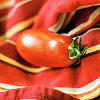

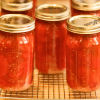

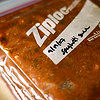
Not-Really-Bolognese Pasta Sauce
2 to 2-1/2 pounds ground meat*
3 cups chopped onion
4 to 6 cloves garlic, minced
12 oz white mushrooms, sliced
1T olive oil
3 quarts home-canned whole tomatoes, undrained (or 3 cans Muir Glen whole peeled tomatoes, with their juice, cut into chunks with kitchen shears)
2 cups tomato sauce
6 oz tomato paste (1 small can)
1 bottle (750 ml) red wine
1T kosher salt
2T dried Italian herbs (we use a combination of 2 parts thyme, 1 part rosemary and 1 part oregano from our garden; if using fresh herbs, triple the amount)
3/4 cup finely chopped flat-leaf parsley
Fry the meat in a large stockpot, breaking up into very small pieces. Add the onion and sweat until soft. Meanwhile, sautee the sliced mushrooms with the olive oil in a separate pan over medium heat until liquid evaporates; do not add salt. When onion is soft, add the garlic to the meat and cook 2 minutes. Drain off most of the fat from the meat and add the mushrooms, tomatoes, salt, herbs, tomato sauce, and tomato paste. Rinse out the tomato cans or jars with the wine, and add to the pot.
Cook for 2 to 3 hours (depending on the amount of liquid in your tomatoes), or until thickened to a dense sauce-like consistency. Add the chopped parsley and remove from the heat. Chill over an ice-water bath to room temperature, then chill overnight if desired. Package in 2-cup quantities in quart-sized freezer bags, and freeze flat.
Each bag will contain enough sauce to coat a half-pound of cooked dried pasta in the American style, to serve 2 to 3. After reheating, we like to add a bit of the pasta water and/or a touch of cream to the sauce before tossing with the pasta, to help the texture recover from the freeze-thaw cycle.
* Our ratio is usually something like 1-1/2 pound ground chuck, 1/2 pound ground pork, and 2 Italian sausages.
Italian, locavore, preserving & infusing, recipes
7 Comments »




Posted by Anita on 09.28.07 7:11 AM
 The folks at The Spirit World sure picked a doozy for the inaugural episode of their “Raiders of the Lost Cocktail” challenge. I spent many evenings thumbing through my bar library, searching for recipes featuring Liquore Strega, and found precisely one mention of this saffron-tinted herbal liqueur.
The folks at The Spirit World sure picked a doozy for the inaugural episode of their “Raiders of the Lost Cocktail” challenge. I spent many evenings thumbing through my bar library, searching for recipes featuring Liquore Strega, and found precisely one mention of this saffron-tinted herbal liqueur.
Excitement quickly turned to despair as I noted the drink’s name: The Strega-nator.
Oh, please. Spirits snob that I am, I didn’t give it so much as a second glance. There’s no way in hell I am making a drink called the Strega-nator, much less putting it on the blog. I’d never be able to show my face at Mixology Monday again! I headed back to the drawing board, muttering under my breath about slapped-together cocktails with frat-boy names, cursing the editors who foist them on their unsuspecting readers.
Next, I hit the public library. Even among dozens of titles both old and new, I didn’t uncover many options. My curiosity was piqued, though, by a UK-published book that suggested mixing Strega with Orange Smash Squash. I consulted our City’s guru of British comestibles, who promptly dashed my hopes again. Orange Squash was nothing short of “putrid” said Sam: “I wouldn’t trust anyone who suggests you put it in a cocktail.” (After having personally sampled it — I found a bottle in the British foods section at Mollie Stone’s — I’m inclined to agree. It’s something like the bastard stepchild of SunnyD and Hi-C Orange, neither of which has any place in my kitchen, much less my bar.)
Once you’ve sunk to the depths of imported kiddie-colored juice substitutes, there’s nowhere to go but up. Having all the necessary ingredients on hand, I grudgingly gave the Strega-nator a whirl. And damned if it wasn’t tasty. Especially considering that it has no base liquor as its spine, it’s a fine drink. Well-balanced, nuanced, perhaps a tad sweet for my taste, but the herbal finish is quite bewitching. After much hand-wringing, I came to the realization that we’d all lived through one Drink of the Week with a god-awful name; why not make it a pair?
Unfortunately, I can’t imagine that a cocktail recipe published 18 months ago could really be considered “lost” for the purposes of the challenge. (Unless, of course, everyone else took one look at the name and flipped right past it, too — a distinct possibility.) I’ve got a few tricks up my sleeve, plus a full bottle of Strega and enough time before the challenge ends; there just might be another entry in the works.
As Arnold would say: “I’ll be back.”





Strega-nator
– published in Food & Wine Cocktails 2006
credited to BLT Prime, New York City
2 oz Strega
1 oz fresh orange juice
1 oz fresh lime juice
2 oz chilled club soda
1 orange wedge, for garnish
Fill a cocktail shaker with ice. Add the Strega and juices, and shake well. Strain into an ice-filled rocks glass, and top with club soda. Garnish with the orange wedge.
cookbooks, Drink of the Week, drinks, other blogs
11 Comments »




Posted by Anita on 09.27.07 8:04 PM
 Making your own preserves may not exactly be the world’s simplest kitchen task. But if you limit yourself to a relatively small batch, and pick the right recipe — preferably one that avoids the canning process altogether — it can be a lot of fun. A lot more enjoyable than say, the back-breaking labor and knuckle-biting stress of processing 100 pounds of San Marzano tomatoes. (Details on that soon… promise.)
Making your own preserves may not exactly be the world’s simplest kitchen task. But if you limit yourself to a relatively small batch, and pick the right recipe — preferably one that avoids the canning process altogether — it can be a lot of fun. A lot more enjoyable than say, the back-breaking labor and knuckle-biting stress of processing 100 pounds of San Marzano tomatoes. (Details on that soon… promise.)
Tomato jam may seem like an odd beast, but it’s really not too far removed from ketchup. My favorite use for this spicy-savory preserve is spread liberally onto good Acme white bread, topped with Fatted Calf bacon and a wedge of Will’s avocado — a sort of post-summer BLT substitute. (We served tea-sized versions of these exact sandwiches at our housewarming party, and they disappeared faster than I could assemble them.) The jam also makes a glorious glaze for meatloaf, a dipping sauce for empanadas… really, the possibilities seem endless.
If you want to simplify even further, omit the seeding and straining. It won’t hurt the flavor of the final product, and it shaves another 15 or 20 minutes off your prep. Myself, I prefer the seedless version. But then, I am all about gilding the lily.
Need more bright ideas for preserving summer’s veggie bounty? Over at The Passionate Cook, Johanna’s hosting this month’s edition of “Waiter, there’s something in my…. [Savoury Preserves]”. Check back here in a few days for a link to the roundup in the comments.



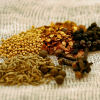

Spicy Tomato-Bourbon Jam
3/4 cup sugar
3/4 cup bourbon
3/4 cup cider vinegar
3 pounds tomatoes (preferably dry farmed)
1 tsp black peppercorns
8 whole allspice berries
8 whole cloves
1 tsp red-pepper flakes
1/2 tsp mustard seeds
1/2 tsp whole cumin seeds
Combine the vinegar, sugar, and bourbon in a glass or ceramic bowl. Stir to dissolve sugar, then set aside.
Prepare an ice-bath. Stem the tomatoes, but do not score them or remove their cores. Working in batches, blanch the tomatoes in boiling water until their skins start to split — a step beyond what you’d normally do if you wanted the tomatoes to stay firm. The timing will depend on each tomato’s size and ripeness, so keep tongs or a slotted spoon handy to check them regularly. As soon as each tomato splits, remove it and plunge into ice water. Peel off tomato skins and discard.
Make a spice sachet by placing all of the spices in the center of a square of cheesecloth and tying into a bundle with a piece of kitchen string.
Set a wide-mesh strainer over a medium bowl. Pull open each tomato gently, and use your fingers to remove the seeds and seed jelly from each pocket, letting them fall into the strainer. Place the seeded tomato pulp onto a cutting board set over a rimmed cookie sheet.
When all tomatoes are seeded, rough-chop them and place them in a large saucepan along with any juices from the cutting board. Add the vinegar-sugar-bourbon mixture and the spice sachet, and bring to a boil. Do not leave unattended, as the mixture will greatly expand as it comes to a boil.
 Using a spatula or wooden spoon, push the liquid surrounding the seeds through the strainer as much as possible. (This is where much of the flavor hides, so don’t stint here.) When you’re left with a dryish mass of seeds, discard them and add the liquid in the bowl to the saucepan, along with any puree on the underside of the strainer.
Using a spatula or wooden spoon, push the liquid surrounding the seeds through the strainer as much as possible. (This is where much of the flavor hides, so don’t stint here.) When you’re left with a dryish mass of seeds, discard them and add the liquid in the bowl to the saucepan, along with any puree on the underside of the strainer.
Reduce the heat to medium and, stirring occasionally, cook the tomato mixture 45 minutes or until it reaches a jammy consistency. Discard spice bag and divide tomato jam among sterilized jars or transfer to a container with tight-fitting lid. Let cool on countertop, then refrigerate until ready to use.
Note: Because this jam is not processed for storage, it must remain refrigerated. It will keep for about a month, provided you use a clean spoon every time.
farmers markets, locavore, other blogs, preserving & infusing, recipes
6 Comments »




Posted by Cameron on 09.21.07 7:07 AM
 “The history of the world, my sweet;
“The history of the world, my sweet;
Is who gets eaten and who gets to eat.”
— Sweeney Todd
We’re headed to the thyuh-tuh tonight for a performance of “Sweeney Todd: The Demon Barber of Fleet Street.” Here’s the short version: Crazy barber kills people, crazy restaurateur bakes them into meat pies, hilarity ensues.
I’ve loved the show since I first heard the music as an impressionable youth. How can you not like a musical with a showstopping number that muses about how different people would taste if you served them wrapped a tender, flaky crust?
While you digest that macabre notion, here’s a little something to wash it down. We’ve tinkered with the recipe a tad, but the name and the basic ingredients are original.





Sweeney’s Cocktail
1 1/2 oz brandy
1/2 oz pineapple juice
1/8 oz Maraschino liqueur (or to taste)
1/4 to 1/8 oz lemon juice
3 dashes Angostura bitters
Shake all ingredients well with ice. Strain into a chilled cocktail glass. Garnish with lemon twist, if desired.
Drink of the Week, drinks, literary, recipes
12 Comments »




 You learn the darndest things when you blog.
You learn the darndest things when you blog.














 Atomic-Age Martini
Atomic-Age Martini Las Vegas is perhaps the last place on the planet you’d expect to find anyone attempting to practice the
Las Vegas is perhaps the last place on the planet you’d expect to find anyone attempting to practice the  I distinctly recall the first time I drank a Whiskey Sour. Our friends Jason and Maggie, eking their way through grad school, lived in East Palo Alto (pre Four Seasons, pre Ikea). Their apartment sat tucked behind a bungalow facing the 101 frontage road. The neighbor who lived in said bungalow was an affable fellow named Drew, a long-haired techie, musician, and tinkerer. The bungalow inevitably became the scene of numerous jam sessions: late-night sing-alongs fueled by a potent mixture of whiskey, powdered sugar, ice, and the juice of the Meyer lemons that grew right outside Drew’s kitchen window… all whizzed up in the blender. (Hey, we were young.)
I distinctly recall the first time I drank a Whiskey Sour. Our friends Jason and Maggie, eking their way through grad school, lived in East Palo Alto (pre Four Seasons, pre Ikea). Their apartment sat tucked behind a bungalow facing the 101 frontage road. The neighbor who lived in said bungalow was an affable fellow named Drew, a long-haired techie, musician, and tinkerer. The bungalow inevitably became the scene of numerous jam sessions: late-night sing-alongs fueled by a potent mixture of whiskey, powdered sugar, ice, and the juice of the Meyer lemons that grew right outside Drew’s kitchen window… all whizzed up in the blender. (Hey, we were young.)






















 The folks at The Spirit World sure picked a doozy for the inaugural episode of their “
The folks at The Spirit World sure picked a doozy for the inaugural episode of their “

















